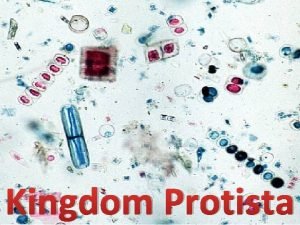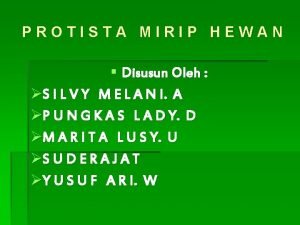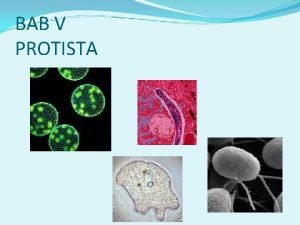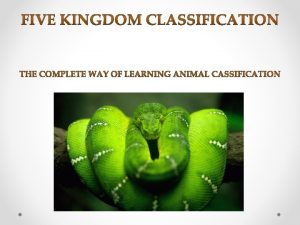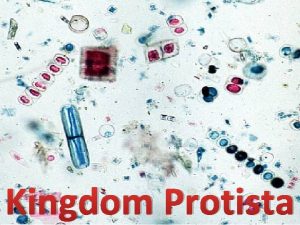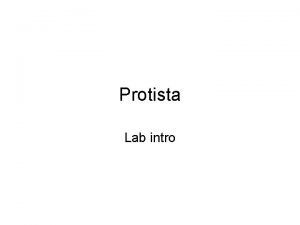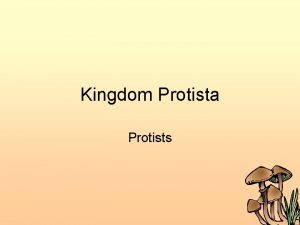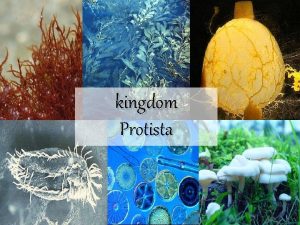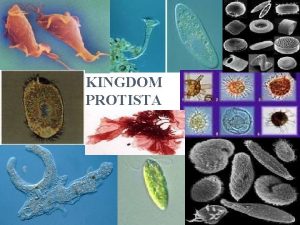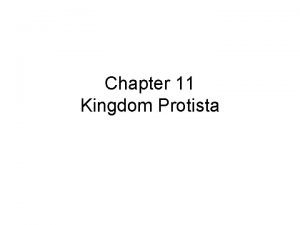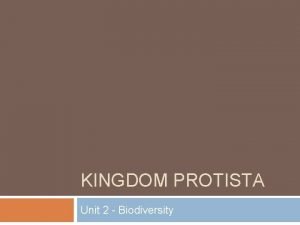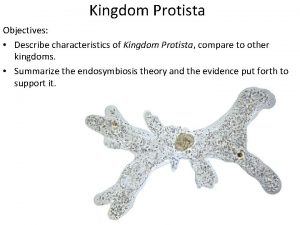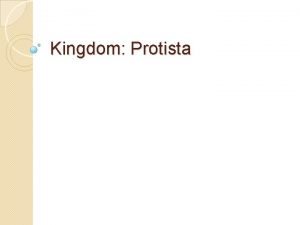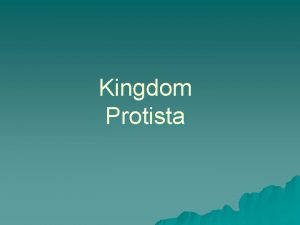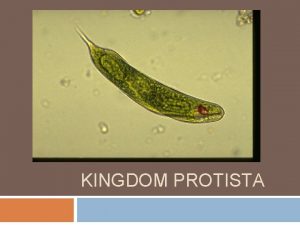Kingdom Protista What is a Protist A Protist














- Slides: 14

Kingdom Protista

What is a Protist? �A Protist is any organism that is not a plant, animal, fungus, or prokaryote. �Very diverse kingdom �Single celled Multicellular �Range in size from μm to 50 m+ �Plant like, animal like and fungus like!

Evolution of Protists �Protista comes from Greek words meaning “the very first” �First eukaryotes (1. 5 billion years ago) �May have evolved through the endosymbiosis of prokaryotic cells

Classification of Protists �Grouped according to how they obtain nutrition. � 3 main groups: animal like plant like fungus like

Animal-like Protists �Once called protozoa (first animals) �Heterotrophs �unicellular �Grouped according to their method of movement. � 4 Groups: Zooflagellates Sarcodines Ciliates Sporozoans

Zooflagellates �Belong to phylum Zoomastigina �Swim using flagella �Feed by absorbing �Live in lakes, streams, and bodies of other organisms �Examples: Trichonympha & Trypanosoma

Sarcodines � Belong to phylum Sarcodina � Live in water � Use pseudopods for movement and feeding � Example: Amoeba � move by streaming cytoplasm into pseudopods (amoeboid movement) � http: //www. youtube. com/watch? v=7 p. R 7 TNz. J_p. A

� Other sarcodines: � Foraminiferans have shells made of Ca. CO 3 � Heliozoans (radiolarians) have shells made of Si. O 2

Ciliates � Belong to phylum Ciliophora � Use cilia for movement and feeding � Most complex unicellular protists � Example : Paramecium � http: //www. youtube. com/watch? v=fmw. N_m. D 7 Tv. Y

�Special features of ciliates: �Trichocysts for defense �Macronucleus – working nucleus �Micronucleus – “back up copy” of genes �Become genetically different by conjugation

Sporozoans �Belong to phylum Sporozoa �No means of movement �All parasitic with complex life cycles involving more than one host �Example: Plasmodium (causes malaria)


Diseases caused by Animal-like Protists �African sleeping sickness �Dysentary �Malaria

Ecology of Animal-like Protists �Some live symbiotically within other organisms �Parasites �Decomposers �Part of food chain
 Old kingdom middle kingdom new kingdom
Old kingdom middle kingdom new kingdom Nnn ruled
Nnn ruled Old kingdom middle kingdom new kingdom
Old kingdom middle kingdom new kingdom Capital of egypt during the old kingdom
Capital of egypt during the old kingdom Domain eukarya, kingdom plantae
Domain eukarya, kingdom plantae Characteristics of protoctista
Characteristics of protoctista Kingdom archaebacteria
Kingdom archaebacteria General characteristics of protista
General characteristics of protista Phyrophyta
Phyrophyta Plasmodial slime mold vs cellular slime mold
Plasmodial slime mold vs cellular slime mold Ciri umum protista
Ciri umum protista Importance of kingdom protista
Importance of kingdom protista Classification of protista
Classification of protista Kingdom protista characteristics
Kingdom protista characteristics Protista lab
Protista lab







